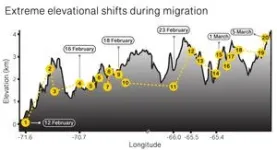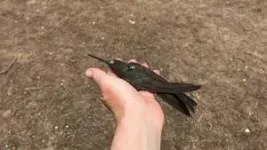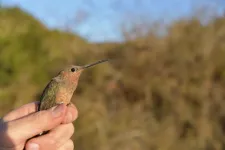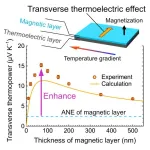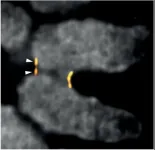For release: May 13, 2024
Ithaca, NY—The Giant Hummingbird of western South America is not one species but two, according to an international group of researchers. The northern population stays in the high Andes year-round while the southern population migrates from sea level up to 14,000 feet for the nonbreeding months. The two species appear identical. But looks deceive—their genomes and behaviors tell a different story. The paper announcing the find was published this week in the journal Proceedings of the National Academy of Sciences.
“These are amazing birds,” said lead author Jessie Williamson, a National Science Foundation Postdoctoral Fellow and Rose Postdoctoral Fellow at the Cornell Lab of Ornithology. “They’re about eight times the size of a Ruby-throated Hummingbird. We knew that some Giant Hummingbirds migrated, but until we sequenced genomes from the two populations, we had never realized just how different they are.”
“They are as different from each other as chimpanzees are from bonobos,” said senior author Chris Witt at the University of New Mexico. “The two species do overlap on their high elevation wintering grounds. It’s mind-boggling that until now nobody figured out the Giant Hummingbird mystery, yet these two species have been separate for millions of years. ”
At first, the research goal was simply to learn where the migratory population went—a journey tracked with geolocators and satellite transmitters. The researchers actually tracked 8 individual hummingbirds migrating up to 5,200 miles from the Chilean coast up to the Andes of Peru and back. Williamson says that’s one of the longest, if not the longest hummingbird migration in the world. The out-and-back journey is longer than the distance from New York City to Istanbul, Turkey.
The authors say the shift in migratory behavior is what drove speciation, though there’s no way to tell whether migratory behavior was gained by one species or lost by the other. Until now, there had been only one known species on this branch of the hummingbird family tree, while the Giant Hummingbird’s closest relatives––the world’s smallest hummingbirds––diversified into 165 distinct hummingbird species.
The researchers are proposing straightforward common names: Northern Giant Hummingbird and Southern Giant Hummingbird. The southern migrant species will retain the Latin name, Patagona gigas. The proposed scientific name for the resident northern population is Patagona chaski. "Chaski" is Quechua for “messenger.” Quechua is the name for a family of Indigenous languages that spread from Peru to other neighboring countries.
The researchers relied on support and local knowledge from landowners and villages in Peru and Chile. Co-author Emil Bautista’s village in Peru was a homebase for this project and the community supported the scientists’ work. But even with more than 15 years of field experience, Bautista admits this fieldwork was the hardest he’s ever done.
“Capturing Giant Hummingbirds is very challenging,” he said. “They watch everything and they know their territories well. We had to be strategic in choosing sites for our nets. If Giant Hummingbirds see something unusual, they won’t visit that spot. They are more observant than other birds.”
Right now, Giant Hummingbird populations, north and south, are stable and the species are common within their ranges—some even visit backyard nectar feeders. The team plans to continue research on these enigmatic birds.
“We have to figure out where these two forms come together and how they interact,” said Witt. “Do they compete, is one dominant over the other, how might they partition resources, and do they mix or spatially segregate within the winter range? Lots of interesting questions to pursue!”
“I’m really interested in how Southern Giant Hummingbirds make such dramatic shifts in elevation during migration. They travel from sea level to the high Andes in just a few weeks,” said Williamson. “They’re like miniature mountain climbers. How do they change their physiology to facilitate these movements?”
Reference:
Williamson, JL, EF Gyllenhaal, SM Bauernfeind, E Bautista, MJ Baumann, CR Gadek, N Ricote, PP Marra, F Bozinovic, ND Singh, and CC Witt. 2024. Extreme elevational migration spurred cryptic speciation in giant hummingbirds. Proceedings of the National Academy of Sciences. https://doi.org/10.1073/pnas.2313599121
END
World's largest hummingbird is actually two species
Surprise discovery found “hiding in plain sight”
2024-05-13
(Press-News.org)
ELSE PRESS RELEASES FROM THIS DATE:
New findings released from US 2020 Facebook and Instagram election study
2024-05-13
In the weeks before and after the 2020 presidential election, researchers ran a number of tests to try to understand how much Facebook and its corporate cousin, Instagram, may be contributing to the nation's political divide.
One of those experiments — led by Matthew Gentzkow and Hunt Allcott, economics professors at Stanford University — centered on more than 35,000 Facebook and Instagram users who were paid to stay off the platforms in the run-up to Election Day. There’s a lot that researchers could glean from the social media hiatus, including whether people’s political attitudes shifted and in what ways. If views changed dramatically, that ...
How miniature backpacks led to the discovery of the world’s largest hummingbird species
2024-05-13
Researchers from UNM’s Museum of Southwestern Biology (MSB) have uncovered the giant hummingbird’s extreme long-distance migration for the first time. Their eight-year study, Extreme elevational migration spurred cryptic speciation in giant hummingbirds published this week in Proceedings of the National Academy of Sciences, led them to another important discovery: The world’s largest hummingbird is a new species.
The team, led by Jessie Williamson, UNM Ph.D., 2022, included the Museum of Southwestern Biology at UNM, Pontificia Universidad Católica de Chile in Chile, and Centro de Ornitología ...
New synthetic biomarker technology differentiates between prior Zika and dengue infections
2024-05-13
A newly discovered Zika virus-specific synthetic molecule is capable of differentiating Zika-immune patient samples from samples of patients previously infected with the related dengue virus. The technology may lead to the development of better diagnostics and vaccine candidates, scientists announced today in the Proceedings of the National Academy of Sciences.
The study, led by researchers at the University of Pittsburgh School of Public Health and The Herbert Wertheim UF Scripps Institute for Biomedical Innovation & Technology, is the first to apply an innovative “epitope surrogate” technology to Zika. Until now, researchers and clinicians have lacked diagnostic ...
Fruit fly testes offer potential tool against harmful insects
2024-05-13
A way to curb nagging insects has been flying under our radar—an enzyme from fruit fly testes.
The compound could control bugs that carry disease and harm crops by stunting their ability to procreate, Johns Hopkins University researchers found.
“We have a toe in the door to control fruit fly populations with this enzyme,” said Steven Rokita, a professor of chemistry at Johns Hopkins who led the research. “It could offer a good way to control fertility of all kinds of biological and agricultural pests, starting with mosquito populations.”
The findings are set to publish ...
Exceptionally large transverse thermoelectric effect produced by combining thermoelectric and magnetic materials
2024-05-13
1. A NIMS research team has demonstrated for the first time ever that a simple stack of thermoelectric and magnetic material layers can exhibit a substantially larger transverse thermoelectric effect—energy conversion between electric and heat currents that flow orthogonally to each other within it—than existing magnetic materials capable of exhibiting the anomalous Nernst effect. This mechanism may be used to develop new types of thermoelectric devices useful in energy harvesting and heat flux sensing.
2. Seebeck effect-based ...
Researchers identify fastest rate of natural carbon dioxide rise over the last 50,000 years
2024-05-13
CORVALLIS, Ore. – Today’s rate of atmospheric carbon dioxide increase is 10 times faster than at any other point in the past 50,000 years, researchers have found through a detailed chemical analysis of ancient Antarctic ice.
The findings, just published in the Proceedings of the National Academy of Sciences, provide important new understanding of abrupt climate change periods in Earth’s past and offer new insight into the potential impacts of climate change today.
“Studying the ...
Research on centromere structure yields new insights into the mechanisms of chromosome segregation errors
2024-05-13
Researchers from the Kops group in collaboration with researchers from the University of Edinburgh, made a surprising new discovery in the structure of the centromere, a structure that is involved in ensuring that chromosomes are segregated properly when a cell divides. Mistakes in chromosome segregation can lead to cell death and cancer development. The researchers discovered that the centromere consists of two subdomains. This fundamental finding has important implications for the process of chromosome segregation and provides new mechanisms underlying erroneous divisions in cancer cells. The research was published in Cell on May 13th 2024.
Our bodies consist of trillions of ...
Ochsner Medical Center-Baton Rouge earns Acute Stroke Ready Certification from Joint Commission
2024-05-13
BATON ROUGE, La. – Ochsner Medical Center - Baton Rouge has earned The Joint Commission’s Gold Seal of Approval® and the American Stroke Association’s Heart-Check mark for Acute Stroke Ready Certification.
The designation means OMC-Baton Rouge meets The Joint Commission's designation for readiness to treat patients who experience severe stroke.
To achieve certification, OMC-Baton Rouge underwent a rigorous, unannounced onsite. During the visit, a team of Joint Commission reviewers evaluated compliance with numerous certification standards, including ...
CEHD researchers studying family-led early childhood systems change for educational equity
2024-05-13
CEHD Researchers Studying Family-Led Early Childhood Systems Change For Educational Equity
Colleen Vesely, Associate Professor, College of Education and Human Development (CEHD); Bethany Letiecq, Associate Professor, Research Methods, CEHD; Rochelle Davidson Mhonde, Assistant Professor, Global and Community Health; and Jung Yeon Park, Assistant Professor of Quantitative Research Methods, School of Education, received funding for the project: “Family-Led Early Childhood Systems Change ...
Raz receives funding for Intent-Based Orchestration In Distributed Command & Control (IBODC2) software
2024-05-13
Raz Receives Funding For Intent-Based Orchestration In Distributed Command & Control (IBODC2) Software
Ali ...
LAST 30 PRESS RELEASES:
Securing AI systems against growing cybersecurity threats
Longest observation of an active solar region
Why nail-biting, procrastination and other self-sabotaging behaviors are rooted in survival instincts
Regional variations in mechanical properties of porcine leptomeninges
Artificial empathy in therapy and healthcare: advancements in interpersonal interaction technologies
Why some brains switch gears more efficiently than others
UVA’s Jundong Li wins ICDM’S 2025 Tao Li Award for data mining, machine learning
UVA’s low-power, high-performance computer power player Mircea Stan earns National Academy of Inventors fellowship
Not playing by the rules: USU researcher explores filamentous algae dynamics in rivers
Do our body clocks influence our risk of dementia?
Anthropologists offer new evidence of bipedalism in long-debated fossil discovery
Safer receipt paper from wood
Dosage-sensitive genes suggest no whole-genome duplications in ancestral angiosperm
First ancient human herpesvirus genomes document their deep history with humans
Why Some Bacteria Survive Antibiotics and How to Stop Them - New study reveals that bacteria can survive antibiotic treatment through two fundamentally different “shutdown modes”
UCLA study links scar healing to dangerous placenta condition
CHANGE-seq-BE finds off-target changes in the genome from base editors
The Journal of Nuclear Medicine Ahead-of-Print Tip Sheet: January 2, 2026
Delayed or absent first dose of measles, mumps, and rubella vaccination
Trends in US preterm birth rates by household income and race and ethnicity
Study identifies potential biomarker linked to progression and brain inflammation in multiple sclerosis
Many mothers in Norway do not show up for postnatal check-ups
Researchers want to find out why quick clay is so unstable
Superradiant spins show teamwork at the quantum scale
Cleveland Clinic Research links tumor bacteria to immunotherapy resistance in head and neck cancer
First Editorial of 2026: Resisting AI slop
Joint ground- and space-based observations reveal Saturn-mass rogue planet
Inheritable genetic variant offers protection against blood cancer risk and progression
Pigs settled Pacific islands alongside early human voyagers
A Coral reef’s daily pulse reshapes microbes in surrounding waters
[Press-News.org] World's largest hummingbird is actually two speciesSurprise discovery found “hiding in plain sight”

